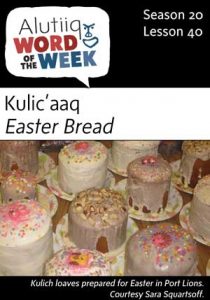 Kulic’aaq–Easter Bread
Kulic’aaq–Easter Bread
Paas’kaami kulic’aalitaartut.–At Easter they always make Easter bread.
Kulic’aaq is the Alutiiq word for the sweet bread baked, decorated, and eaten by the Orthodox faithful every Easter. Similar to Italian panettone, this rich bread contains milk, eggs, butter, sugar, nuts, fruit, and a variety or flavorings like vanilla, rum, orange zest, cardamom, and saffron. Kulic’aaq, like perok (fish pie), is one of the foods that reflect Kodiak’s Russian heritage.
People bake these distinctive loaves in tall cylindrical tins, sometimes using a coffee can. They are made in many different sizes, but the loaves are typically tall and rounded on the top, a shape that symbolizes the domes of Russian Orthodox churches. Like cakes, loaves of kulich are often frosted or glazed then brightly decorated with candies or flowers.
Families begin baking kulich the week before Easter, and each has their own recipe. You can ask about their list of ingredients, but not everyone will share! Most people do not eat this rich bread until breaking their Lenten fast. Families may take their bread to church for a blessing and then enjoy the loaf with a large dinner after Easters services. The loaf is cut in half lengthwise and then each half sliced. Some people serve it with cheese pashka, another Easter food. Others like their kulich toasted and buttered.[xyz-ihs snippet=”Adsense-responsive”]Kulich consumption typically continues over the forty-day Easter season, until Pentecost. This seventh Sunday after Easter commemorates the decent of the Holy Spirit upon the disciples and marks the end of Easter celebrations.
Some Kodiak Islanders recall that they were making kulich in 1964, when the Great Alaska Earthquake began. The trembling started on Good Friday as the faithful were preparing Easter foods.
Source:
